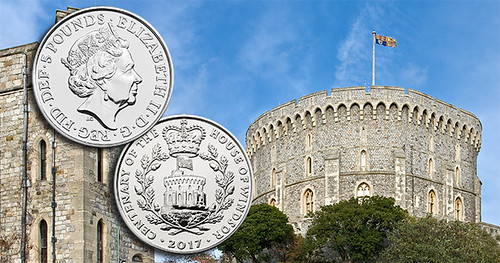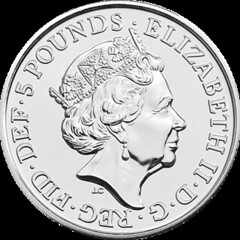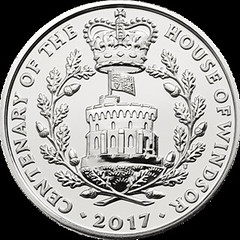
PREV ARTICLE
NEXT ARTICLE
FULL ISSUE
PREV FULL ISSUE
THE HOUSE OF WINDSOR CENTENNIAL CROWNA May 17, 2017 Coin Update article by Michael Alexander examines the new Royal Mint coin celebrating the centennial of the House of Windsor. Here's an excerpt.
-Editor
 On January 1, the Royal Mint unveiled a new Crown coin that marks the centennial anniversary of the introduction of the British Royal family’s dynastic name—that of Windsor, which was introduced in 1917. The circumstances of why the British Royal family changed its dynastic name were wholly due at the time to the consequences of what was referred to as the Great War, which began in 1914 (see below). The name of Windsor continues today, and it has been decreed by royal ascent by the current British head of State, HM Queen Elizabeth II, that the name of the dynasty should survive into the next succeeding generations and heirs to the British throne. The coin is designed by Timothy Noad and includes a fitting representation of the dynasty’s name: a depiction of Windsor Castle’s Round Tower flying the royal standard, surrounded by a wreath of acorn and leaf clusters, symbolizing English oak trees. St. Edward’s crown is placed just above the royal standard. CENTENARY OF THE HOUSE OF WINDSOR surrounds the primary design, and the coin’s year of issue, 2017, is placed below. The obverse includes the fifth effigy of HM Queen Elizabeth II, designed by Jody Clark and in use since 2015, along with the denomination, 5 POUNDS. The precious-metal versions include the edge lettering THE CHRISTENING OF A DYNASTY. The Brilliant Uncirculated coin is encased in a colorful presentation blister-pack folder. The silver Proof editions, issued in both traditional crown and piedfort strikes, are each housed in a custom presentation case with certificate of authenticity.   The Creation of a Truly British Royal Dynasty The creation of the royal family’s dynasty 100 years ago is unusual in the sense that it was done as a measure to show the people of Great Britain that their royal family was truly British in every way, with the exception of their roots and dynastic heritage. Although the history of the royal family teaches us that their claim to the English (later the British) throne spans back a millennium, technically speaking, the current royal family observed their dynastic tercentenary in 2014 with the anniversary of the arrival of the Elector and Prince George of Hanover to the United Kingdom. The German prince was recognized as the new king of Great Britain after the death of the country’s last Stuart monarch, Queen Anne, in 1714. The Hanover dynasty reigned in the United Kingdom until the death of Queen Victoria in 1901, as she was the last Hanoverian born in the male line to succeed to the British throne. It had been understood that a new dynasty would eventually be introduced onto the British throne as a consequence of the 1840 marriage of Queen Victoria to Prince Albert of Saxe Coburg and Gotha. Upon the accession of their son, King Edward VII, Hanoverian rule ended, and the new dynasty, that of Saxe Coburg and Gotha, was recognized. As a result of the United Kingdom’s declaration of war on the German Empire in 1914, a wave of anti-German sentiment swept through the British Isles. At the height of the war, it came to the attention of King George V that a newspaper had described him as “uninspiring and alien,” to which he reportedly replied, “I may be uninspiring—but I’ll be damned if I’m an alien!” There arose the question of what name should be adopted by the royal family. There was no English version of their dynastic name, and the actual surname of Saxe Coburg and Gotha was disputed as being either “Wettin” or “Guelph” (both very Germanic in their origins). It was suggested by the government that they adopt the name of the seat and traditional place of residence of the royal family: Windsor. The change was seen as perfect. The name’s association with the thousand-year-old castle and its place in British history would reflect both the tradition of the monarchy as an institution and the continuity necessary to assert the right of the current royal family to claim the British crown. Great history lesson, and a nice coin to boot. The proof issues have quite low mintage - 5,500 for the silver, and only 884 gold. -Editor
To read the complete article, see:
Wayne Homren, Editor The Numismatic Bibliomania Society is a non-profit organization promoting numismatic literature. See our web site at coinbooks.org. To submit items for publication in The E-Sylum, write to the Editor at this address: whomren@gmail.com To subscribe go to: https://my.binhost.com/lists/listinfo/esylum All Rights Reserved. NBS Home Page Contact the NBS webmaster 
|